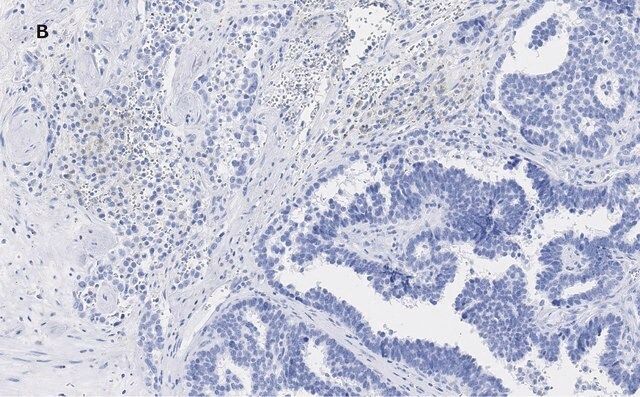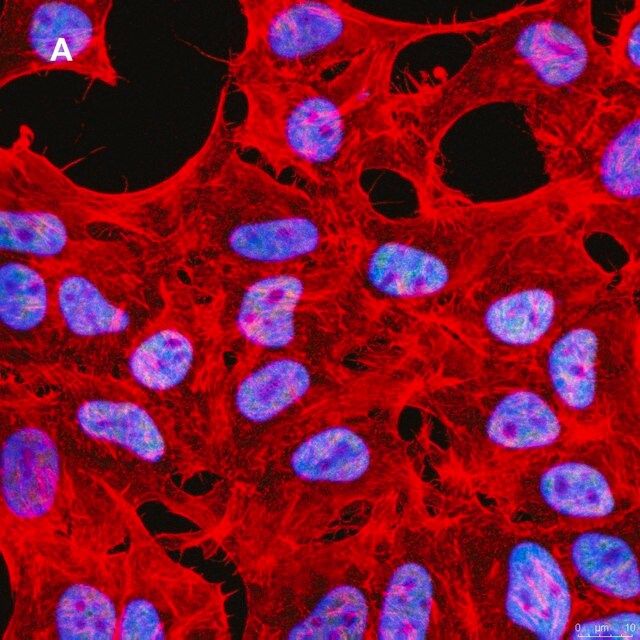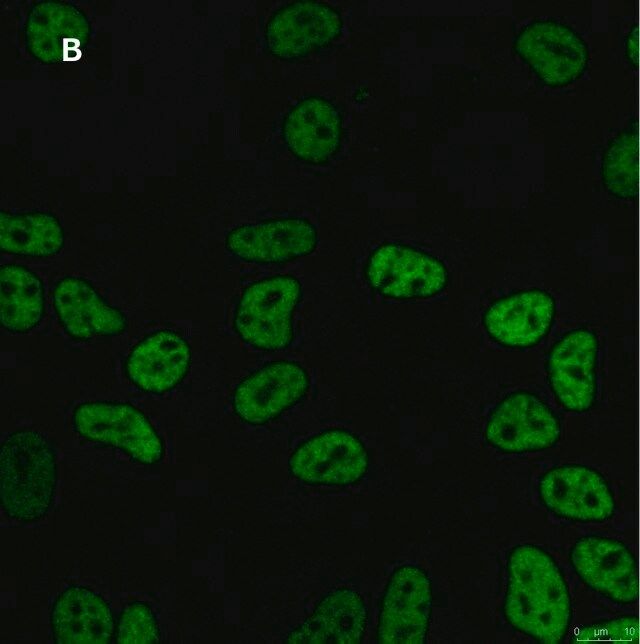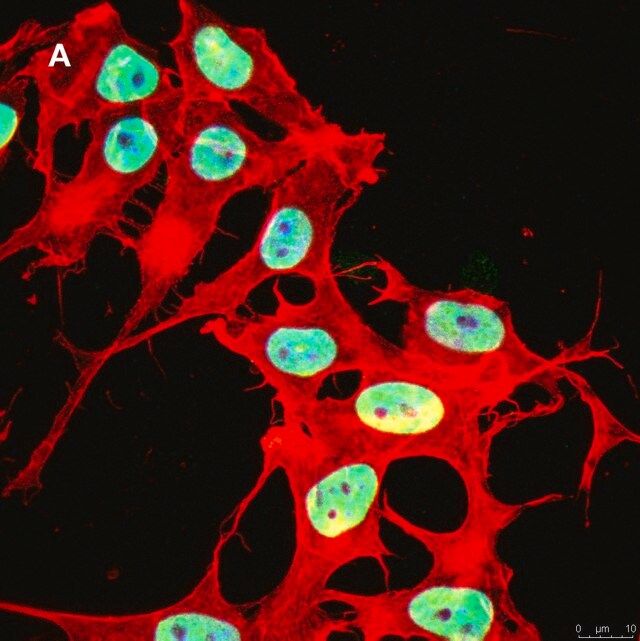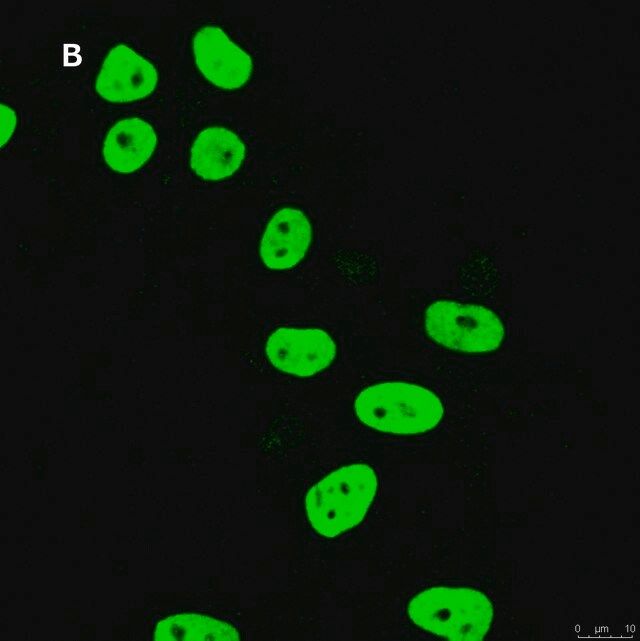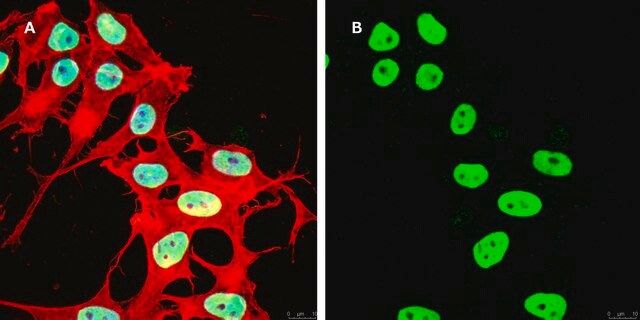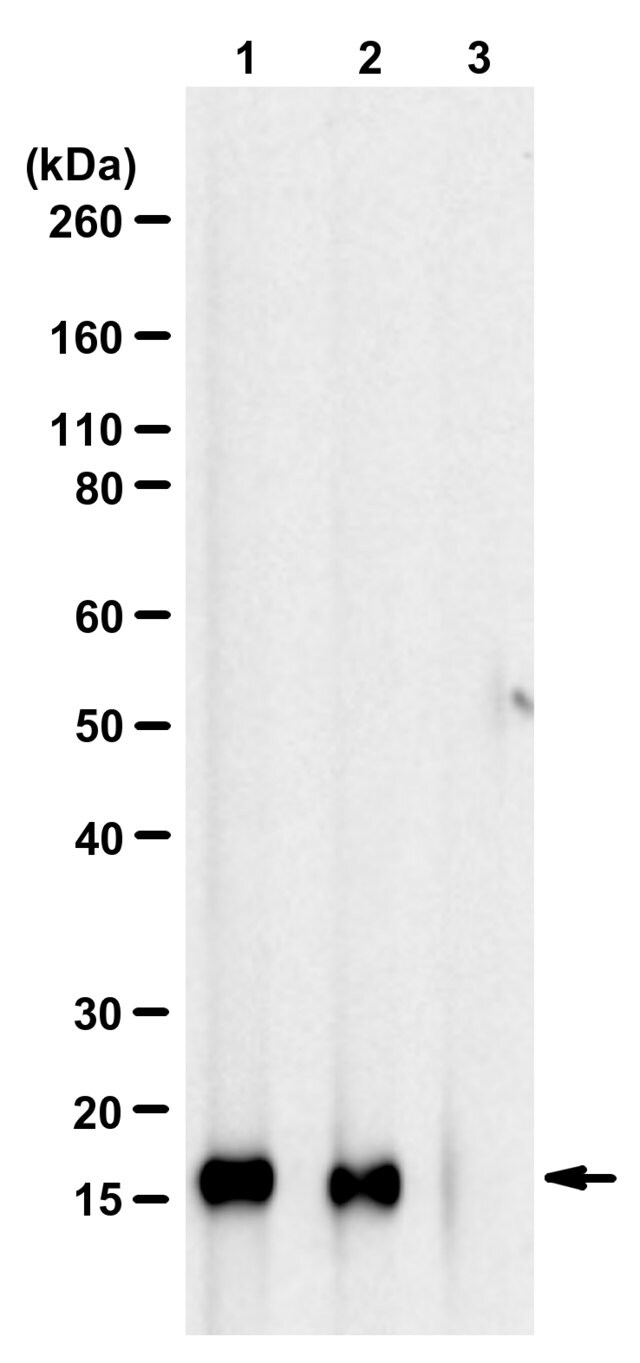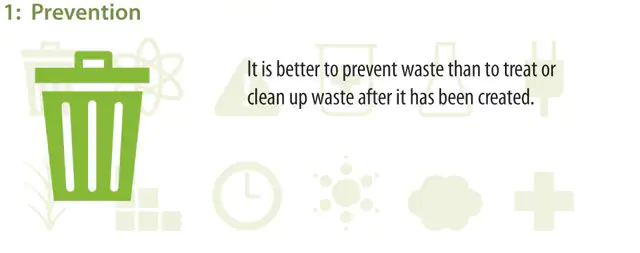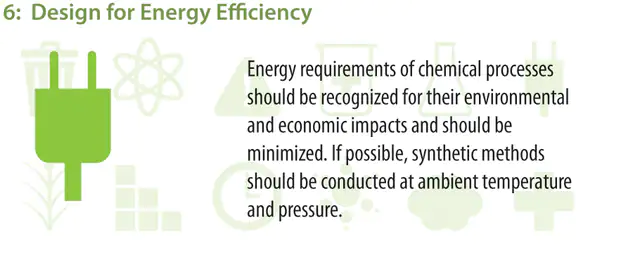您的位置:首页 > 产品中心 > Anti-Acetyl Histone H3 (Lys9 and 14) Antibody, clone 5H20, ZooMAb® Rabbit Monoclonal
Anti-Acetyl Histone H3 (Lys9 and 14) Antibody, clone 5H20, ZooMAb® Rabbit Monoclonal
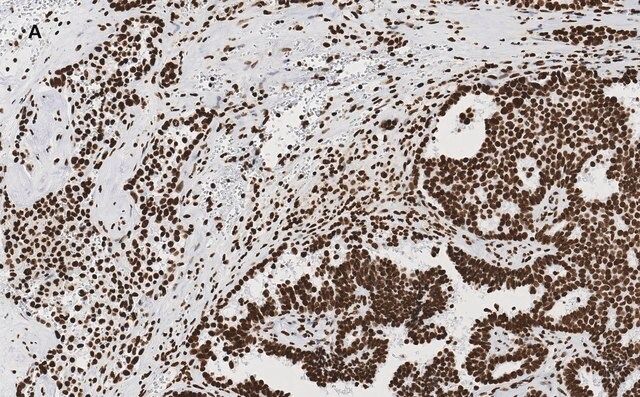


| 产品编号: | 4082715 |
| 规格: | recombinant, expressed in HEK 293 cells |
| 包装规格: | 25 μL,4 X 25 μL |
| 产品类别: | 进口试剂 |
| 品牌: | Sigma-Aldrich |
| 优惠价: | 立即咨询 |
产品别名
Anti-Acetyl Histone H3 (Lys9 and 14) Antibody, clone 5H20, ZooMAb® Rabbit Monoclonal
H3K9
H3t
Histone H3.1t
14
H3/t
14Ac
H3/g
Histone H3 Ac Lysine 9
产品性质
| biological source【生物来源】 | rabbit (recombinant) |
| recombinant【重组】 | expressed in HEK 293 cells |
| conjugate【偶联物】 | unconjugated |
| antibody form【抗体形式】 | purified antibody |
| antibody product type | primary antibodies |
| clone【克隆】 | 5H20, monoclonal recombinant monoclonal |
| product line【产品线】 | ZooMAb® learn more |
| form【形式】 | lyophilized |
| mol wt【分子量】 | calculated mol wt 15.51 kDa observed mol wt ~16 kDa |
| species reactivity | human |
| species reactivity (predicted by homology) | rat, mouse |
| packaging【包装】 | antibody small pack of 25 μL |
| greener alternative product characteristics【环保替代产品特性】 | Waste Prevention Designing Safer Chemicals Design for Energy Efficiency Learn more about the Principles of Green Chemistry. |
| enhanced validation【增强验证】 | recombinant expression Learn more about Antibody Enhanced Validation |
| technique(s) | immunocytochemistry: 1:100-1:1,000 immunohistochemistry (formalin-fixed, paraffin-embedded sections): suitable using 1:100 inhibition assay: suitable using 1:1,000 (peptide) western blot: suitable using 1:1,000 |
| isotype【同位素/亚型】 | IgG |
| UniProt accession no.【UniProt登记号】 | Q16695 |
| greener alternative category【环保替代产品分类】 | |
| shipped in【运输】 | ambient |
| storage temp.【储存温度】 | 2-8℃ |
| Gene Information | human ... HIST3H3;H3FT(8290) |
基本信息
| General description【一般描述】 | ZooMAb antibodies represent an entirely new generation of recombinant monoclonal antibodies. Each ZooMAb antibody is manufactured using our proprietary recombinant expression system, purified to homogeneity, and precisely dispensed to produce robust and highly reproducible lot-to-lot consistency. Only top-performing clones are released for use by researchers. Each antibody is validated for high specificity and affinity across multiple applications, including its most commonly used application. ZooMAb antibodies are reliably available and ready to ship when you need them. Learn more about ZooMAb here. |
| Specificity【特异性】 | Clone 5H20 is a ZooMAb rabbit recombinant monoclonal antibody that specifically detects Histone H3 acetylated on lysines 9 and 14. |
| Immunogen【免疫原】 | KLH-conjugated linear peptide corresponding to the first 21 amino acids (without methionine) surrounding acetylated lysines 9 and 14 of human Histone H3. |
| Application【应用】 | Anti-Acetyl Histone H3 (Lys9 and 14), clone 5H20, ZooMAb, Cat. No. ZRB06599, is a recombinant Rabbit Monoclonal Antibody that specifically targets Histone H3 acetylated on Lysines 9 and 14 and has been tested for use in Immunocytochemistry, Immunohistochemistry (Paraffin), Peptide Inhibition, & WB. Immunocytochemistry Analysis: A 1:1,000 dilution from a representative lot detected Acetyl Histone H3 (Lys9 and 14) in HeLa cells treated with Trichostatin A (TSA). Immunohistochemistry (Paraffin) Analysis: A 1:100 dilution from a representative lot detected Acetyl Histone H3 (Lys9 and 14) in human breast cancer tissue sections. Peptide Inhibition Analysis: A 1:1,000 dilution from a representative lot was used with HeLa cells treated with Sodium Butyrate for peptide block analysis. |
| Physical form【外形】 | Purified recombinant rabbit monoclonal antibody IgG, lyophilized in PBS with 5% Trehalose, normal appearance a coarse or translucent resin. Contains no biocide or preservatives, such as azide, or any animal by-products. Larger pack sizes provided as multiples of 25 μL. |
| Reconstitution【重悬】 | 300 μg/mL after reconstitution at 25 μL. Please refer to guidance on suggested starting dilutions and/or titers per application and sample type. |
| Legal Information【法律信息】 | ZooMAb is a registered trademark of Merck KGaA, Darmstadt, Germany |
产品说明
| Target description【目标描述】 | Histone H3.1t (UniProt: Q16695; also known as H3/t, H3t, H3/g) is encoded by the HIST3H3 (also known as H3FT) gene (Gene ID: 8290) in human. Histones are highly conserved basic nuclear proteins that are responsible for the nucleosome structure of chromatin in eukaryotes. They play a central role in transcription regulation, DNA repair, DNA replication and chromosomal stability. DNA accessibility is regulated via a complex set of post-translational modifications of histones, also called histone code, and nucleosome remodeling. Two molecules of each of the four core histones (H2A, H2B, H3, and H4) form an octamer, around which DNA is wrapped in repeating units, called nucleosomes, which limits DNA accessibility to the cellular machineries that require DNA as a template. Histone H3 features a main globular domain and a long N-terminal tail, which protrudes from the globular nucleosome core and can undergo several different types of epigenetic modifications that influence cellular processes. Acetylation of histone H3 occurs at several different lysine positions in the histone tail and is performed by a family histone acetyl transferases. Histone H3 can also undergo methylation as well as acetylation on lysine 9. Acetylation on lysine 9 (H3K9ac) is reported to impair methylation at arginine 9 (H3R8me2s). A balance between acetylation and methylation is important for the establishment of specific chromatin structures. Acetylation of lysine 14 (H3K14Ac) is commonly seen in genes that are being actively transcribed into RNA. Histone H3 is reported to be hyperacetylated at lysines 9 and 14 following UV irradiation. Studies have shown that nucleosomes with H3K14ac modification have a higher affinity for purified chromatin remodeling complex RSC (Remodels the Structure of Chromatin) and by anchoring RSC, H3K14Ac plays an important role in the unfolding of strongly positioned nucleosomes during repair of UV damage. This ZooMAb recombinant monoclonal antibody, generated by our propriety technology, offers significantly enhanced specificity, affinity, reproducibility, and stability over conventional monoclonals. (Ref.: Nicolas, E., et al. (2003). Mol. Cell. Biol. 23(5); 1614-1622; Duan, MR., and Smerdon, MJ (2014). J. Biol. Chem. 289(12); 8353-8363). |
| Storage and Stability【储存及稳定性】 | Recommend storage of lyophilized product at 2-8℃; Before reconstitution, micro-centrifuge vials briefly to spin down material to bottom of the vial; Reconstitute each vial by adding 25 μL of filtered lab grade water or PBS; Reconstituted antibodies can be stored at 2-8℃, or -20℃ for long term storage. Avoid repeated freeze-thaws. |
| Disclaimer【免责声明】 | Unless otherwise stated in our catalog or other company documentation accompanying the product(s), our products are intended for research use only and are not to be used for any other purpose, which includes but is not limited to, unauthorized commercial uses, in vitro diagnostic uses, ex vivo or in vivo therapeutic uses or any type of consumption or application to humans or animals. |
安全信息
| Storage Class Code【储存分类代码】 | 11 - Combustible Solids |
| WGK | WGK 1 |





